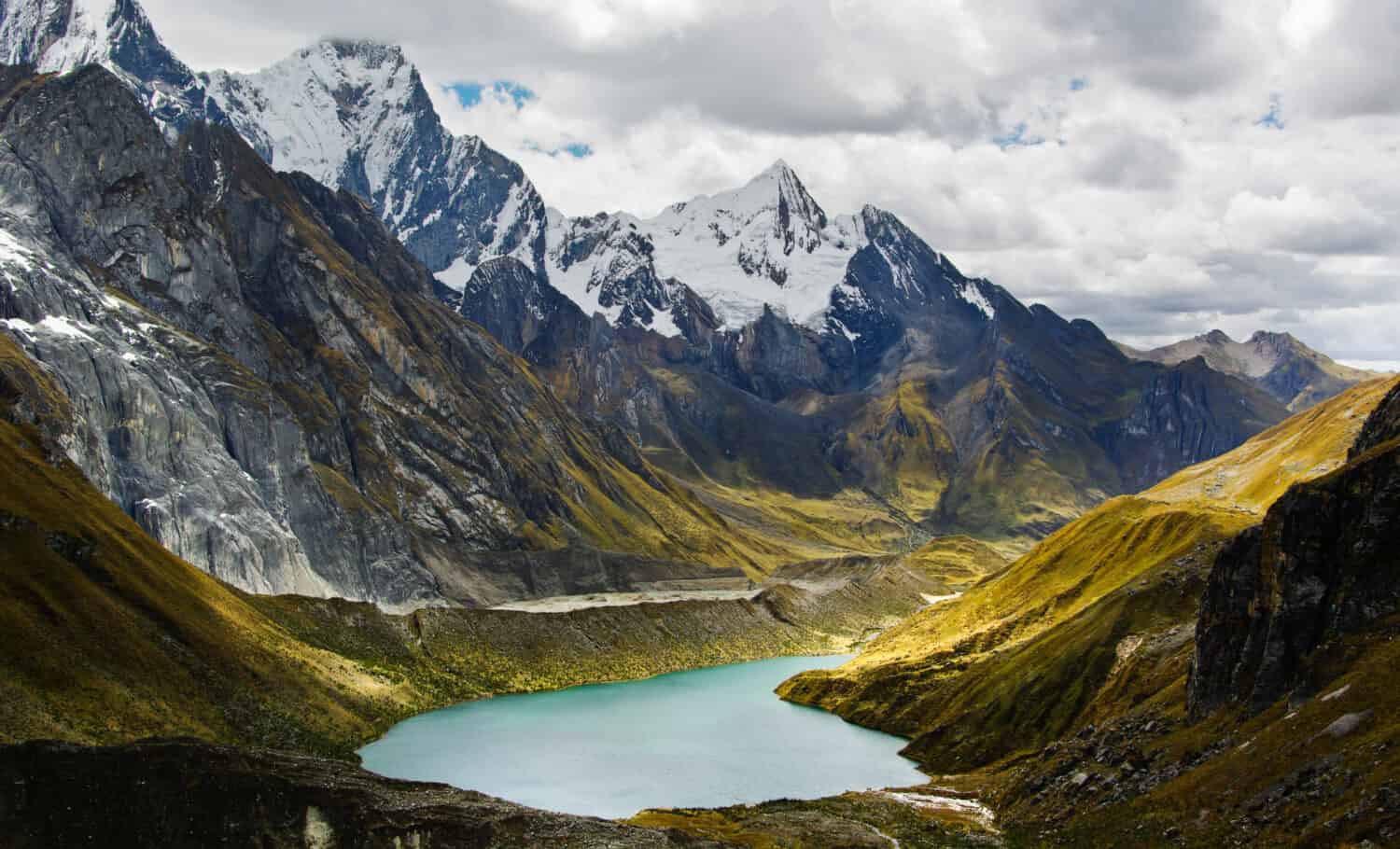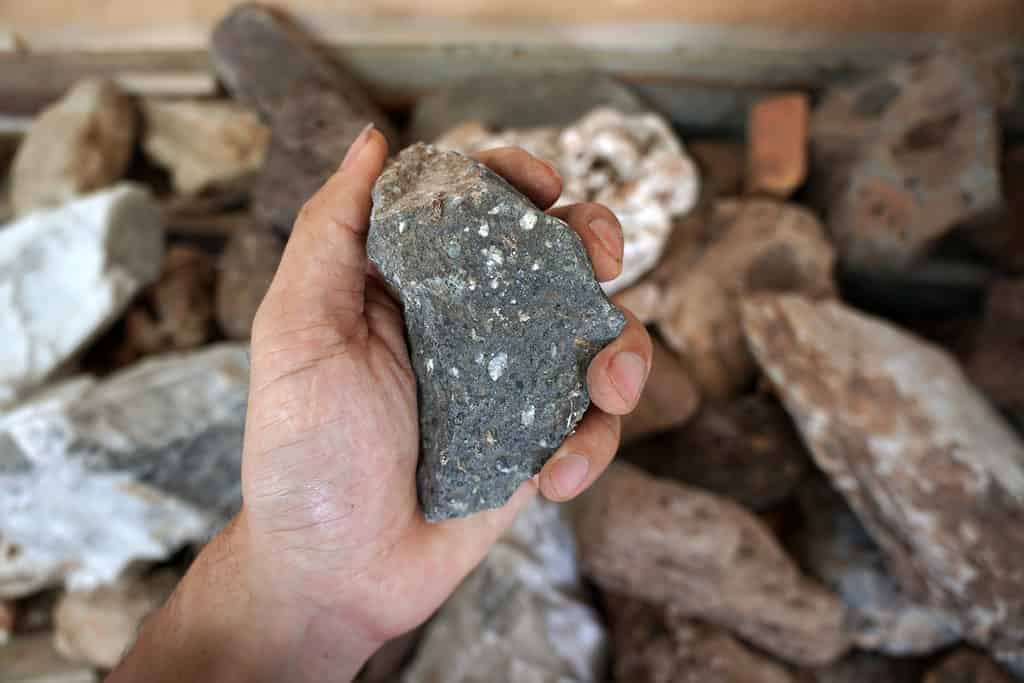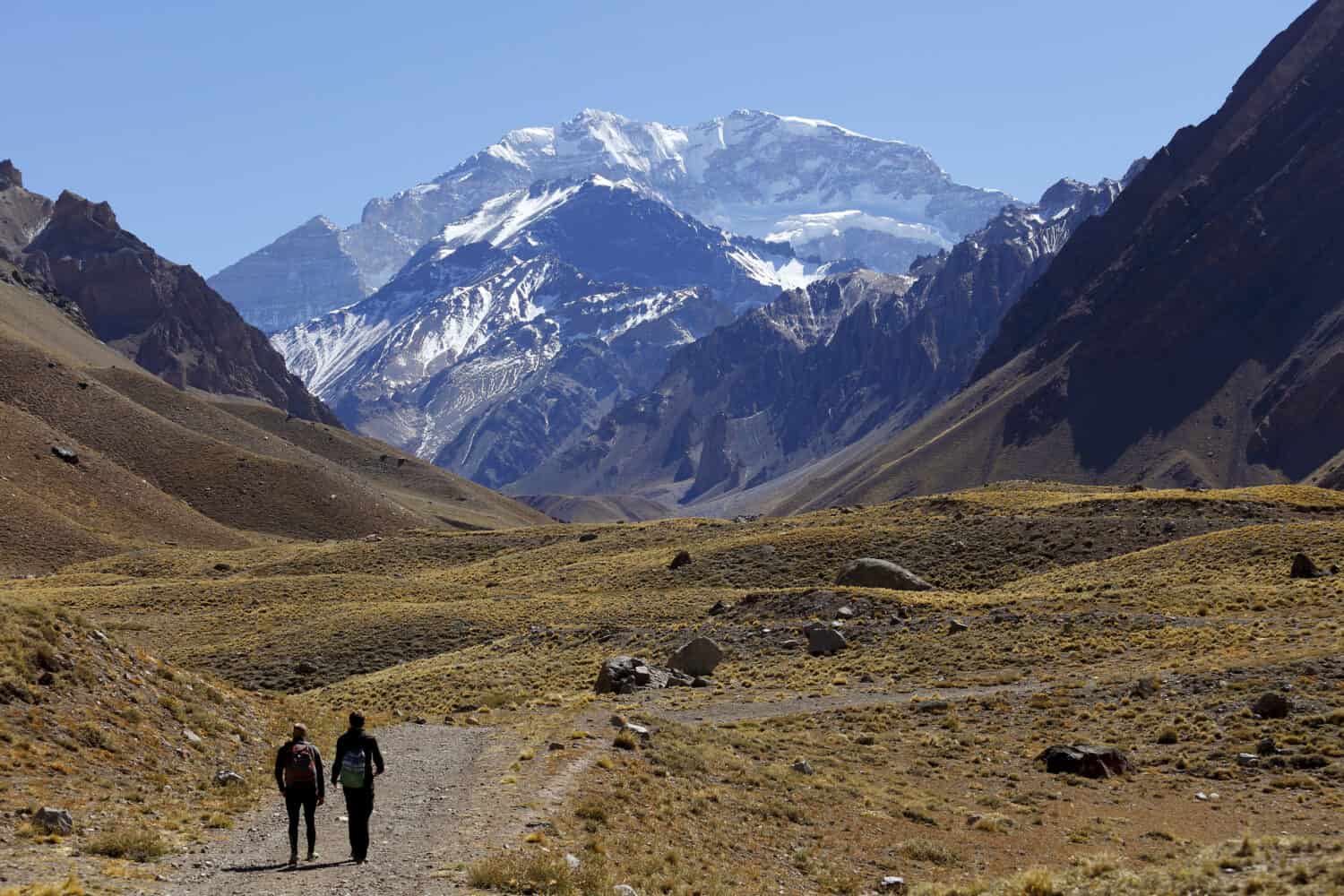Mysterious and captivating, the Andes Mountains have always fascinated those fortunate enough to witness their majestic beauty. Like ancient sentinels, they rise with an air of mystery, guarding the secrets of their birth with unwavering determination. How and when did these breathtaking mountains come into existence? It’s a question that continues to captivate both scientists and curious individuals. It has fueled a desire to uncover the truth behind their awe-inspiring creation for centuries.
In this article, we embark on a journey that takes us deep into the heart of the Andes Mountains. Each step brings us closer to unraveling the intricate tale of their origin. We encounter colossal collisions, mesmerizing volcanic eruptions, and the remarkable natural processes that crafted this timeless work of art. So, let’s embark on this adventure together and dive into the captivating world of the Andes Mountains!
How Were the Andes Mountains Formed?

This unique and beautiful scenery is located in the Southern Patagonia Andes.
©Samuel Ericksen/Shutterstock.com
The Andes Mountains stretch along South America’s western edge. The tremendous forces of tectonic activity shaped them over millions of years. Specifically, they formed as a result of the subduction process, where one tectonic plate slides beneath another. In the case of the Andes, it was the oceanic Nazca Plate that subducted beneath the South American Plate.
As the Nazca Plate continues to subduct, its dense oceanic crust melts and moves upwards. This gives rise to a chain of volcanic arcs. These volcanic arcs make up the Andean Volcanic Belt, which runs parallel to the Andes Mountains. The presence of volcanoes in the region can be attributed to this subduction process and the resulting volcanic activity.
As the oceanic crust continues to subduct, it exerts pressure on the South American plate. This causes it to fold and uplift. This process results in the formation of fold mountains, known as the Andes Mountains. However, it’s worth noting that the uplift of the Andes Mountains has occurred in different stages throughout their history. Let’s explore this formation process further below!
When were the Andes Mountains Formed?

As dense material was removed, the remaining portion of the crust experienced rapid uplift.
©Jujubier/Shutterstock.com
According to research, the formation of the Andes Mountains occurred over a much longer period of time than previously believed. The prevailing view suggests that the Andes mountains were formed roughly six to 10 million years ago. A substantial volume of rock broke off the base of the Earth’s crust due to over-thickening in the region. As this dense material broke away, the remaining portion of the crust experienced rapid uplift, giving rise to the majestic Andes Mountains.
However, recent advancements in techniques allowed researchers to uncover that the uplift of the Andes Mountains started even earlier, approximately 25 million years ago. This uplift has resulted in the extraordinary vertical differential of more than 40,000 feet seen in the present Andean Mountain system.
This finding suggests that the formation of the Andes involved a series of growth spurts rather than a continuous, gradual uplift of the surface. These growth spurts resulted in the creation of the Altiplano plateau in the central Andes. It likely shaped the entire mountain range.
It is important to note that the exact timing of the Andean uplift is still a topic of controversy among scientists. A combination of factors played crucial roles in the formation and shaping of the Andes Mountains throughout their complex history. This includes tectonic activity, subduction of the oceanic crust under the continental crust, and volcanic eruptions.
Where Are the Andes Mountains Located?

This is the Andes Mountains on the way to Fitz Roy, close to El Chalten, Patagonia, Argentina.
©Thousand Travel Tales/Shutterstock.com
The Andes Mountains are located on the western edge of South America, stretching from Venezuela in the north to Chile and Argentina in the south. The mountain range crosses through several countries, including Colombia, Ecuador, Peru, Bolivia, and Chile.
The Andes run parallel to the Pacific coast, creating a natural barrier between the coastal areas and the rest of the continent. This mountain range is considered one of the longest continental mountain ranges in the world, spanning approximately 5,500 miles.
What Is the Geological Significance of the Andes Mountains?

Culpeo foxes live in the Andes mountains.
©iStock.com/tane-mahuta
The geological significance of the Andes Mountains lies in their formation and the processes that shaped them. For example, the Andes Mountains are a result of tectonic activity, including the subduction of the oceanic crust beneath the continental crust. This ongoing collision of tectonic plates has led to the creation of one of the longest mountain ranges in the world. Periodic pulses of rapid uplift likely formed the Altiplano Plateau in the central Andes.
These geological forces have influenced the region in several ways. The Andes Mountains act as a barrier, affecting weather patterns and creating diverse microclimates. The mountains also play a crucial role in the water cycle, capturing moisture from the atmosphere and providing a source of fresh water for surrounding regions. The Andes are home to numerous mineral deposits, including copper, molybdenum, and iron ore, which have significant economic importance.
Moreover, the geological history of the Andes Mountains has shaped the biodiversity of the region. The variations in altitude, climate, and soil composition across the mountain range have created a wide range of habitats. These habitats have contributed to the evolution and diversification of a variety of unique plant and animal species.
The Impact of Andes Mountains’ Geological History on Regional Biodiversity

Queen of the Andes is a beautiful plant in Mount Huascarán, Peru.
©Christian Vinces/Shutterstock.com
The Andes Mountains contain remarkable biodiversity, housing a diverse array of plants and animals. This is primarily due to the significant variations in altitude across the mountain range, which create distinct habitats at different elevations. Such habitat diversity allows for the coexistence of numerous species, each uniquely adapted to its particular environment.
What sets the Andes apart is the presence of many endemic species. This means they do not live anywhere else in the world. Due to the geological and geographical isolation of the mountain range, countless species have diverged and evolved independently. These endemic species are both fascinating and invaluable, serving as a testament to the uniqueness and ecological importance of the Andes Mountains.
Low-Level Elevation Biodiversity
At lower elevations, the Andes feature lush tropical forests that boast an incredible range of plant species. These forests are home to various iconic and charismatic wildlife. This includes jaguars, tapirs, and a multitude of bird species such as toucans, parrots, and hummingbirds. Also, the lower regions of the Andes have rich plant diversity, with countless species. This includes orchids, bromeliads, and ferns adorning the landscape.
Mid-Level Elevation Biodiversity
As one ascends into the mid-elevations of the Andes, the climate becomes cooler and more temperate. This gives rise to unique ecosystems known as cloud forests. These misty forests feature a perpetual shroud of fog, providing ample moisture for a wide range of vegetation. This misty environment fosters the growth of mosses, bromeliads, and epiphytic plants that cling to tree branches. The cloud forests are famous for hosting rare and endemic species. These include the spectacled bear, the Andean cock-of-the-rock bird, and the iconic Andean hummingbirds.
High-Level Elevation Biodiversity
Venturing even higher into the Andes, one encounters the alpine zones. These high-altitude ecosystems experience harsh conditions, including freezing temperatures, strong winds, and limited oxygen. Despite these challenges, unique flora and fauna have adapted to survive in this extreme environment. Peculiar plants like cushion plants and rosette-forming plants have evolved strategies to withstand these harsh conditions. Meanwhile, animals like the vicuña, mountain viscacha, and Andean condor have found ways to thrive in the high altitudes of the Andes.
How Did the Andes Mountains Impact the Human History of South America?

Andesite is an extrusive igneous rock that is very abundant in the Andes Mountains.
©Yes058 Montree Nanta/Shutterstock.com
The Andes Mountains have had a significant impact on the human history of South America. Here are some key ways the Andes have influenced the region:
Geographical Barrier:
The Andes Mountains form a natural barrier, separating the narrow western coastal area from the rest of the continent. This geographical feature has affected the movement of people, trade, and cultural exchanges throughout history. The rugged terrain and high altitudes of the Andes made travel and communication between different regions more challenging, leading to the development of distinct indigenous cultures and societies in different parts of the mountain range.
Resource Availability:
The Andes Mountains have provided various essential resources for human settlements in South America. The mountain range is rich in mineral deposits, including copper, silver, and gold, which have attracted human populations for mining and trade. The fertile soils and water sources originating from the Andes have also supported agriculture, allowing for the development of ancient civilizations such as the Inca Empire, which thrived due to its sophisticated agricultural techniques and the construction of irrigation systems.
Cultural Significance:
The Andes Mountains hold immense cultural significance for the indigenous peoples of South America. These mountains were considered sacred and served as important spiritual and religious sites in traditional Andean cultures. The Incas, for example, believed that the mountains were the dwelling place of powerful deities, and their monumental architecture and religious ceremonies were closely intertwined with the natural landscape of the Andes.
Trade and Transport Routes:
Despite the challenges posed by the rugged terrain, the Andes Mountains have also served as important trade and transport routes throughout history. Ancient trade routes, such as the Inca Road system, connected different regions of the Andes and facilitated the exchange of goods, ideas, and technologies between different cultures. Even today, modern transportation infrastructure, such as highways and railways, traverses the Andes, connecting various cities and facilitating economic activities in the region.
What Are Some Notable Peaks in the Andes Mountains?

Aconcagua, the highest mountain in the Americas at 6.960 mts., is located in the Andes Mountains.
©rocharibeiro/Shutterstock.com
Some notable peaks in the Andes Mountains include:
Aconcagua (Argentina): It is the highest peak in the Andes and the highest mountain outside of Asia, standing at 22,841 feet above sea level.
Huascarán (Peru): It is the highest peak in Peru, reaching a height of 22,204 feet. It is located in Huascarán National Park, a UNESCO World Heritage site.
Ojos del Salado (Argentina and Chile): It is the highest volcano in the world and the second-highest peak in the Andes, standing at 22,615 feet.
Illimani (Bolivia): It is one of the highest peaks in Bolivia, with an elevation of 21,122 feet. It is located near La Paz, the capital city of Bolivia.
Cotopaxi (Ecuador): It is one of the most active volcanoes in the world and stands at 19,347 feet above sea level.
Chimborazo (Ecuador): Although not the highest in terms of elevation, it is the farthest point from the center of the Earth due to the Earth’s equatorial bulge. Chimborazo reaches an elevation of 20,564 feet.
These are just a few examples, as there are numerous named and unnamed peaks throughout the Andes Mountains that offer breathtaking scenery and attract mountain climbers and outdoor enthusiasts from around the world.
In Conclusion
While the prevailing view suggests the Andes Mountains formed between 10 to six million years ago, recent research indicates that their uplift started as early as 25 million years ago through a series of growth spurts. The forces of tectonic activity and volcanic eruptions have left an indelible mark on the breathtaking Andes Mountains we see today.
The Andes Mountains have also had a profound impact on the human history of South America. They have shaped the geography of the region and influenced the development of distinct cultures since the dawn of their formation. They have also provided crucial resources and served as trade and transport routes. The geological significance of the Andes Mountains lies in their formation through tectonic activity. This intricate formation has impacted weather patterns and freshwater resources, creating valuable mineral deposits. It has also had a major influence on regional biodiversity through the creation of diverse habitats.
The ongoing geological processes in the Andes are a marvelous and captivating natural process worth exploring. These mountains continue to shape the landscape and contribute to the rich natural heritage of the region today.
The photo featured at the top of this post is © BonnieBC/Shutterstock.com
Thank you for reading! Have some feedback for us? Contact the AZ Animals editorial team.







